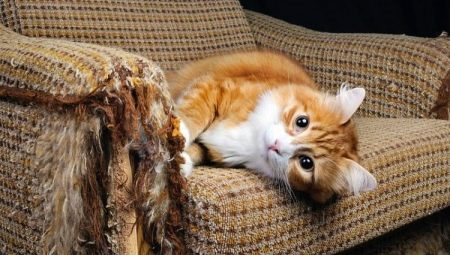Owners of cats are often tormented by the fact that their pets tear apart the upholstery and spoil the wallpaper. The material in this article will help the reader understand what the reasons for this behavior may be and tell you how to wean a cat from tearing furniture and wallpapers.
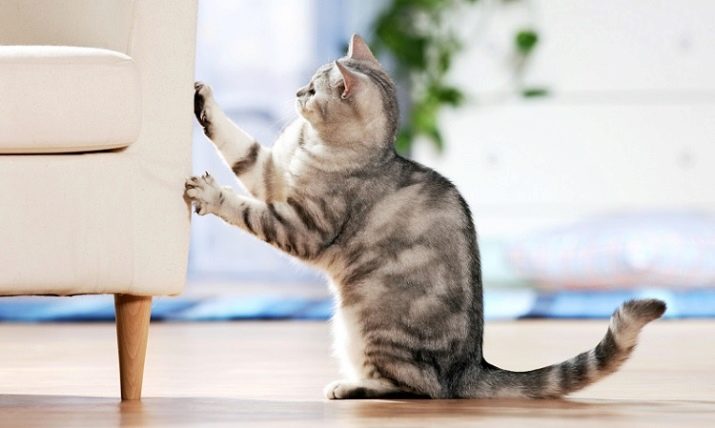
Reasons for this behavior
Usually cats that are raised from young claws quickly understand the rules established in the home. There are several possible reasons why a cat living in the house allows itself to tear up wallpaper and upholstery. Note the main ones.
- Paws Warm Up. Animals need a kind of gymnastics for their paws. By straining and relaxing the muscles of the legs, they maintain themselves in great shape. This charge not only warms up the muscles, but also perfectly develops the paws.
- Stress relief. Often, cats, along with the shit of furniture upholstery, sort it out with its paws and bite its teeth. This is an instinct inherent in small kittens, in many adults it lasts a lifetime. So they calm themselves, relieve stress and completely relax before going to bed.
- Claw sharpening. The stratum corneum of cat's claws is updated by dropping its upper layer. This is possible if the cat nibbles its claws itself, but since it is much easier for it to scratch its claws on a carpet, furniture or wallpaper, this is what it does. This is what animals that live at home do (street ones usually bite their claws into the bark of trees).
- Designation of its territory. There are sweat glands on the pet's paws.The secret with the smell of an animal stands out when the cat marks the territory. The pet does this so that other animals at home do not encroach on the marked sofa or part of the wall, sniffing them. So the cat tells the other animals who is the boss in the house.
- Discomfort from excess length. Cats cannot move comfortably with long claws. Itching appears in the pads of the paws, the nails acquire burrs, walking becomes painful. At this moment, the animal does not care what to tear the claws about, just to get rid of the problem. It can tear not only wallpaper or upholstery, but also wooden furniture.
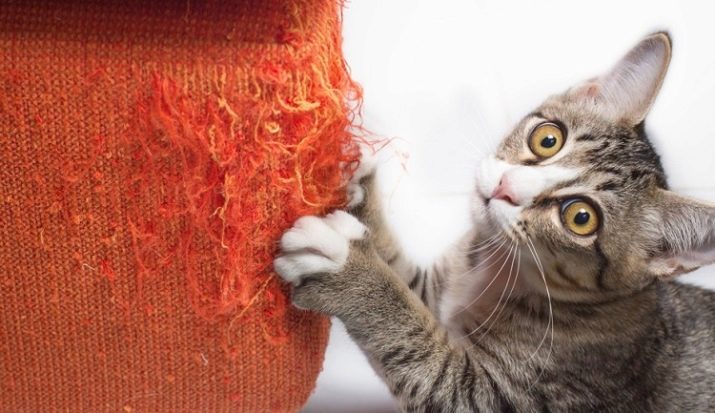
Effective Ways
Weaning a cat to tear furniture and wallpaper is not easy if it is already in her habit. Some owners prefer to change the type of wall and floor coverings. For example, cats are indifferent to plastic panels, ceramic and PVC tiles, high-class laminate, artificial stone and decorative plaster. Someone prefers to cover upholstered furniture with thick fabric lining.
However, one must understand that even a replacement coating or an alternative to him will not be able to permanently wean a cat from scratching its nails and nibbling objects. This process is natural and vital. And therefore it is necessary not only to wean, but also to think how to switch attention to other objects. Consider the most effective protection methods.
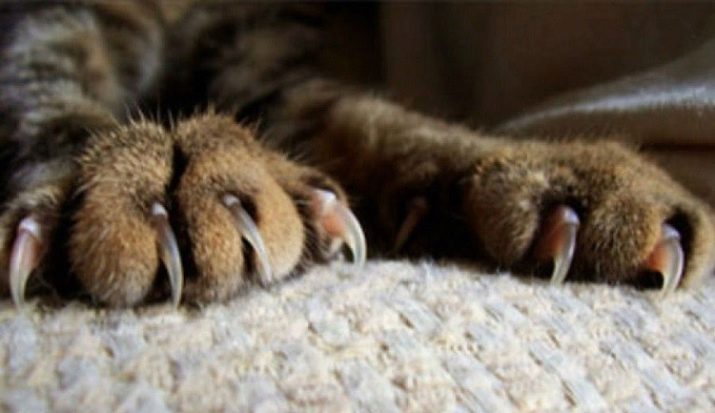
Repellent odors
You can try to wean the pet from a bad habit, having processed your favorite carding places with a product with an unpleasant aroma. It is known that cats do not like the citrus smell, and this is worth using. It can be orange, lemon peel or essential oil. However, the oil is inconvenient in that it leaves unsightly greasy stains on the surface. Some spices may be an alternative to citrus, ether or spray (e.g. coriander or chili) with which it is possible to process some surfaces (unacceptable to the furniture on which a person sits).


Protective coatings
You can save the upholstery of the sofa and chairs by using covers made of special fabric or the so-called anti-vandal euro covers. In specialized stores, you can choose options with a coating that cats can’t handle and can’t claw.
They simply cannot stick their claws into the fabric.
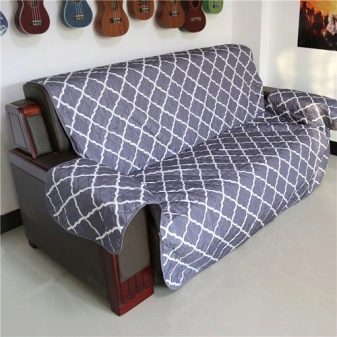
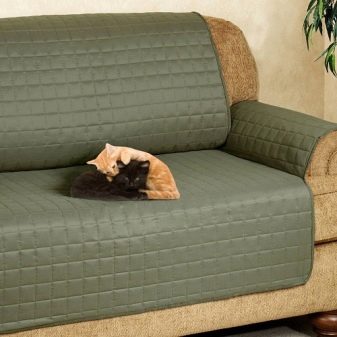
Clipping and claw pads
Wean the cat to scratch the upholstery and spoil the surface of the wallpaper in a more efficient way, by cutting the claws or gluing special plastic overlays on them. To cut the claws get a special device - clipper cutting literally 1-1.5 mm overgrown. The device is quite convenient and allows you not to stretch the procedure, and therefore the cat does not have time to get nervous.
The linings are worn directly on the claws, having previously lubricated them inside with special glue. Do not worry too much about the fact that it is harmful. As practice shows, the glue is not so strong, but for some time the cat will not be able to spoil the furniture upholstery and wallpaper.
Alas, at the same time, she will not be able to pull her claws, and it will be difficult for her to jump, but temporarily she will be able to protect objects.
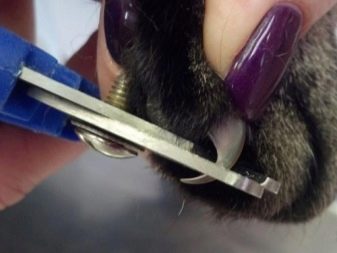

Sprays and Sprays
To prevent the cat from sharpening claws and teeth on furniture, wallpapers and curtains, you can try to use atomizer. Scaring can affect individual individuals if it is done at the moment when the animal is pulling upholstery fabric or wallpaper. You can also spray your favorite subjects special spray to scare away a pet. On some cats, a citrus-smelling spray is repulsive.
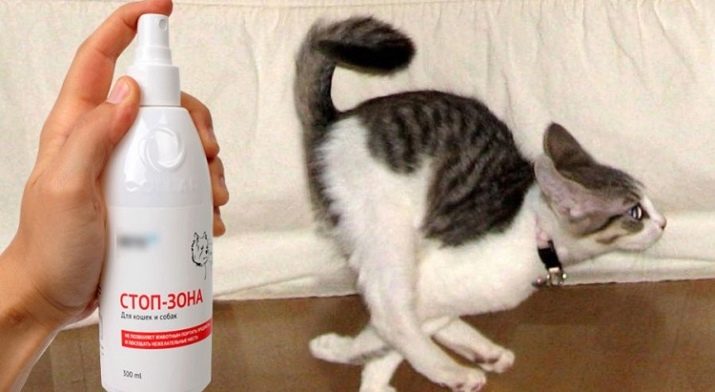
Tools at hand
You can protect furniture and wallpapers in another way. For example, your favorite places on top to stick with sticky, sliding or rustling material. For example, glue double-sided on a ragged place on the wall scotch tape or foil.
Someone prefers to create a scaring noise at the moment when the cat sharpens its claws. To do this, use baby rattles or a bunch of keys.

Scarlet Point
A special claw sharpening device is an excellent and effective way to save both furniture and wall cladding. It can be either an individual subject or a part of a game complex for a cat. Its shape is very diverse, as is the material of manufacture. Cats like big game complexes, because this is their territory, where they can spend a lot of time. And this allows you to save the upholstered furniture of the owners.
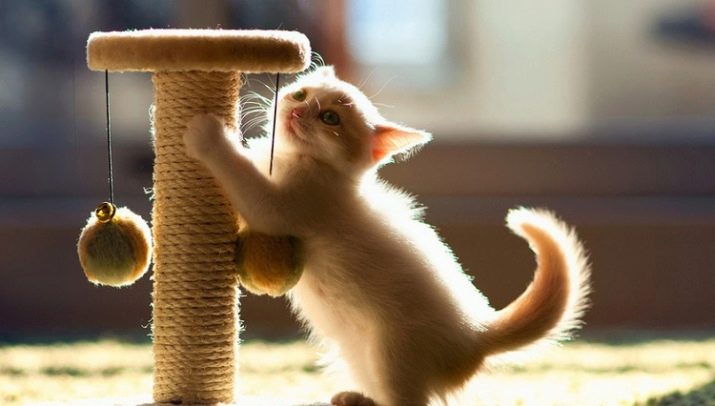
Rules of education and training
So that the cat does not tear furniture and does not scoff at the wall-paper, it will be necessary to accustom it to the scratching post since childhood. From the first days a kitten stays in the house, it is necessary to establish certain rules of behavior. For example, an animal should have its own things, its own tray, scratching post, dishes and a bed. If the pet will sleep in the owner’s bed, it is useless to require him to follow any rules.
It is possible to minimize the risk of damage to furniture and wallpaper by acquiring not one, but two claws. In the presence of free time, they can be done independently, and then put in places where the baby is eyeing. In the early stages of parenting, this may work.
As the animal understands what needs to be done and gets used to it, the claw-tip can be moved to the place most convenient for the owner.
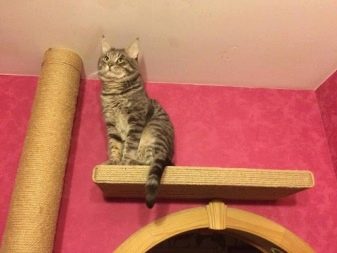
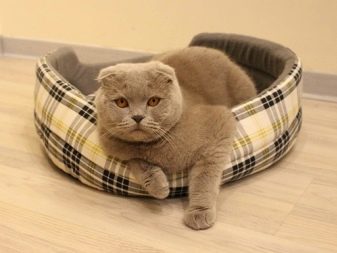
Someone shows the cat the principle of the device, scratching the scratching post with nails. Other owners drive a toy over it so that the cat, whether he wants it or not, scratches the surface. Still others prefer to attract the attention of a pet with special alluring sprays that cats like. Others take the kitten’s foot and scratch the clawhole right with it.
To fix the problem, if it has already appeared, you need to monitor the behavior of the pet. At the stage of raising the baby, you can temporarily adjust, for example, by protecting the walls with wall cladding, which the cat does not like. The corners of the walls can be sheathed with plastic panels.
The choice of a claw-claw is important: its length should correspond to the growth of an animal standing on its hind legs. You can purchase not only a vertical claw point, but also a horizontal one, moreover, its texture should be similar to tree bark. If the pet likes to tear the wallpaper, he needs a vertical claw point, but if he often tears horizontal surfaces (for example, the seat of a sofa or armchair), you should buy a horizontal one. When an animal digs into an object, in addition to its claws, with its teeth, it is worth considering buying a clawcloth with a sunbed.
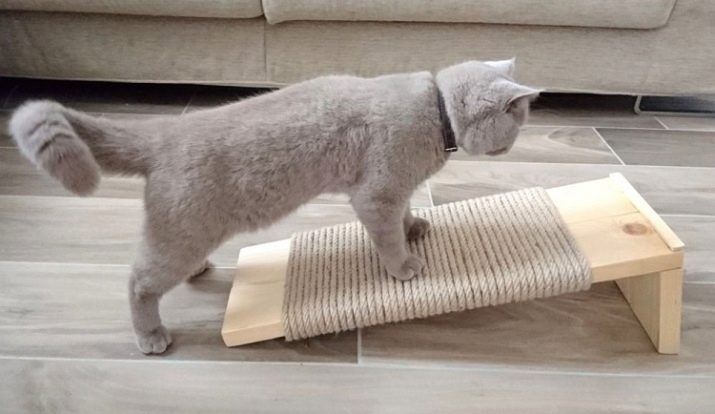
There are times when the pet is completely not interested in the claw point. Then you need to try to change its position and place. If he even sharpened his claws on the column, you need to praise him and encourage. It is worth considering: cats are trained and quickly understand what is required of them. An affectionate voice and reward will help the pet again and again pay attention to the scratching post.
The desired result is often not achieved. Therefore, it is often necessary for the owner to combine different methods to wean a pet from damage to objects. But if the pet will spend a lot of time on the same furniture, it will be considered that this is his place, which means that he can do whatever he wants with it.
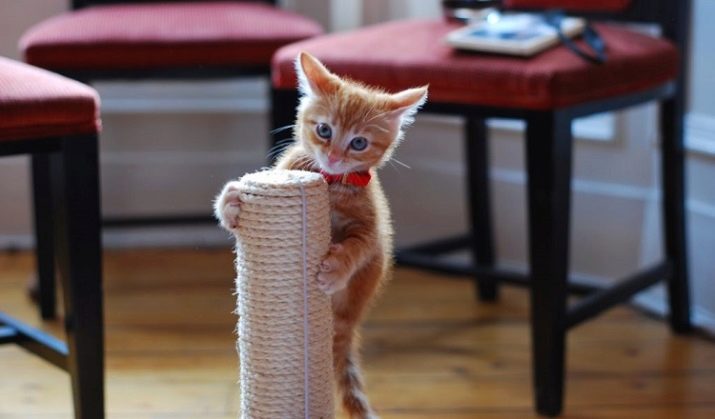
Common mistakes
No matter how it seems to the breeder that he is right, there are nuances that not only do not help, but also create certain obstacles in weaning the cat from stripping furniture upholstery and wall wallpaper.
Physical punishment and screaming
Cats have excellent memory. No matter how they shout at them, they understand the intonation. Considering that they cannot do without scratching and sharpening claws, pets will continue to solve their problems there, but at the moment when the owner turns away. Other members of the feline family will do this on purpose.
There is only one conclusion: each should have their own places and objects, the cat should sleep in his own bed.
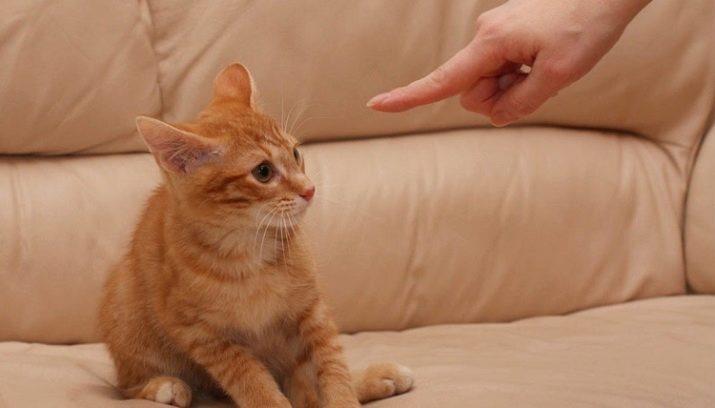
Throwing items
Throwing objects at the pet is not worth it. This will not help, but in addition, it can harm the animal.For instance, an object launched into it may someday hit the target and injure the cat. The point here is not so much in education as in its absence.
If the animal had a scratching post since childhood, he certainly would not have looked at the wallpaper.

The use of aggressive chemistry
Not all products from specialized stores designed to scare cats work properly. Other drugs are so dangerous that they provoke allergic reactions in animals and even humans.. For example, some products are so dangerous that after use they can cause suffocation in households. Others are poisonous to the cat and family members.
Before using such drugs, it is necessary to assess all the risks.
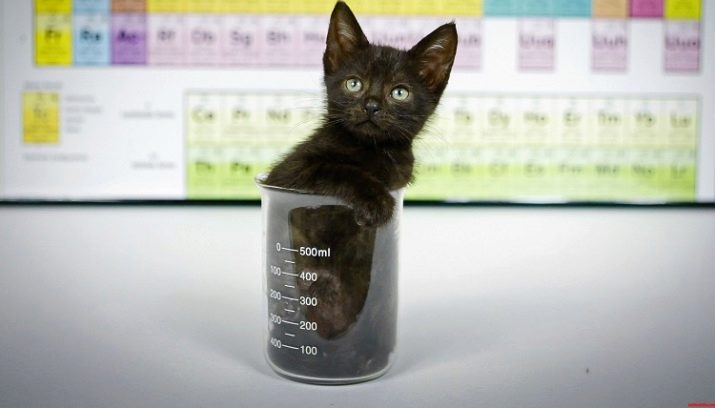
Catnip application
Other methods of attracting to scratching points have the opposite effect to that which we would like to achieve. For example, the same catnip can cause interest in cats, attracting their attention. But instead of using the item for its intended purpose, they can rub it with their fur coat, and also ride on the floor nearby.

What if all the methods do not help?
There are times when cats stubbornly do not want to recognize claws and continue to tear household items with claws and teeth. In this case, you can do different things.
- To begin with, it is worth experimenting with changing the type of surfaces. This can help with wall cladding, but if not, someone simply covers the walls with panels or does not allow the pet to enter the room where it is engaged in “black business”.
- In addition, other owners of harmful cats they put the furniture against the wall, change the upholstery on it. Do not think that this will change the situation, because the wallpaper will remain in other rooms of the home. The pet can do with new strength that furniture and wallpaper that is in other rooms. Less often, he will pay attention to the carpet or carpet (they are thin and not hard enough).
- If the animal has no alternative for scratching and grinding the claws, to do something effective is unlikely to succeed. In this case, the only right decision would be to trim the overgrown claw edge with a claw cutter. For a while, this will save the pet from the discomfort caused by the excessive length of the claws. However, if the reason for his habit lies in stress, he will look for a place to get rid of it.
- As for the situation when the pet not only bites its claws into the upholstery, but also moves it with its paws, then it’s easier to fix the problem: just buy your bed for the animal. A great way out of the situation will be a large game complex with scratching points and anti-vandal coating of upholstered furniture.
- Some cat breeders use balloons for educational purposes.. They are inflated and burst at the moment when the animal starts turning its claws on the upholstery or wallpaper. Other owners hang balls directly in places chosen by the cat. One unsuccessful movement - and a rather unpleasant noise is heard.
- Sometimes owners try to protect furniture with cloaks, about which pets simply cannot sharpen their claws.
- Regarding spraying your pet with water from a water gun or spray gun, this method has its drawbacks. For example, if you do this all the time, when the cat turns his attention to the wallpaper, then the paintings will quickly move away from the wall in places where water will fall on them.
- Sometimes breeders resort to non-standard solutions. One of them is the use of a gas spray, the principle of which is to use special sensors. Devices of this type are installed near the place of regular damage. As soon as the pet comes closer, a daunting spray will fall on it. He will not like this, but far from the first time it can be understood.
- Someone prefers to distract the cat's attention from furniture and wallpaper with toys. Sometimes it works.
- A separate category of breeders resorts to extreme measures: they remove the claws completely. However, this method of getting rid of the problem is cruel and can lead to complications such as arthritis and chronic pain. In addition, this may affect the coordination of animal movements. After such surgical interventions, the animal will no longer be able to climb trees and jump on tall objects. Moreover, it will not be able to protect itself if necessary.

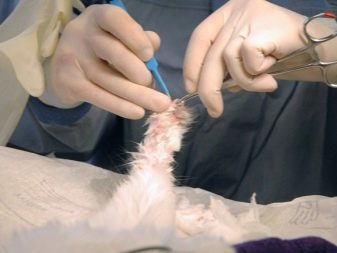
Before you take a kitten, you should think about possible problems: its natural needs should not lead to such consequences. If the problem exists, it is often a lack of upbringing, which the cat owner neglected at one time.
You can learn how to raise a cat by watching the video below.
